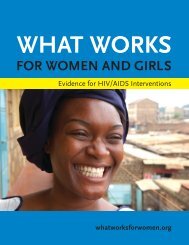Global Tuberculosis Report -- 2012.pdf
Global Tuberculosis Report -- 2012.pdf
Global Tuberculosis Report -- 2012.pdf
You also want an ePaper? Increase the reach of your titles
YUMPU automatically turns print PDFs into web optimized ePapers that Google loves.
evised as a result of the introduction of new technologiesin which culture and DST are invariably performedtogether. In 2011, 19 of the 36 countries in the combinedlist of 22 high TB burden countries and 27 high MDR-TB burden countries did not reach the target (Table 6.1).Of these 36 countries, 9 reported more than 1 laboratoryper 5 million population using line probe assays – a highthroughputtool used at central and regional levels to rapidlydetect resistance to rifampicin and, in some cases,isoniazid. These numbers are changing quickly, as laboratorystrengthening efforts including EXPAND-TB (seeSection 6.3) come to fruition.Quality-assured DST is critical to ensure accuratedetection of drug resistance for subsequent treatmentdecisions and to avoid false diagnoses. External qualityassessment schemes for DST appear to be comprehensivelyinstalled more commonly than those for microscopy.While 42% of countries claim to have a comprehensivescheme for microscopy (as stated above), 71% of the 115low- and middle-income countries and territories indicatingcapacity for DST reported an external quality assessmentscheme encompassing all DST laboratories.The target for culture and DST capacity of 1 laboratoryper 5 million population is likely to be reviseddownwards in future following the introduction of theWHO-recommended automated nucleic amplificationassay Xpert ® MTB/RIF (Cepheid, Sunnyvale, CA, USA).Xpert MTB/RIF technology (see Box 6.1) can detectrifampicin resistance-conferring mutations, has sensitivityfor TB detection equivalent to that of solid culture, andcompared with culture methods it can be used at lowerlevels of the laboratory network. Importantly, however,culture will remain essential for testing of susceptibilityto drugs other than rifampicin, and is currently the onlytool available for monitoring the response to treatment ofthe growing number of patients being treated for MDR-TB. Ongoing evaluation of evidence on the use of XpertMTB/RIF and its impact on the workload of other laboratorydiagnostics, including microscopy, culture and DST,will allow for refinement of the current targets.While a number of countries report suboptimal capacityto detect TB and drug resistance, patients in manyparts of the world still access laboratory testing by seekingcare in the private sector. The quality of diagnosticservices in this sector is highly variable, and some privatepractitioners continue to use diagnostic tests thatare not recommended by WHO. In addition, in some settingslaboratories in the public sector that are not underthe auspices of the national TB control programme alsodiagnose TB without necessarily following recommendedguidelines and quality assurance procedures. Collaborationbetween national TB control programmes and alllaboratories offering TB diagnosis is therefore critical toensure that national guidelines are followed, that appropriatediagnostic tests are used, and that patients diagnosedwith TB are notified to the national TB controlprogramme and receive proper care. In 2011, 15 of 36high burden countries reported some level of collaborationwith laboratories in the private sector; 17 reportedcollaboration with laboratories in the public sector.6.3 Strengthening TB laboratories globally,regionally and nationallyOne of the main prerequisites for strengthening TB laboratorycapacity in countries is dynamic policy reform,adapting WHO guidelines on TB diagnostics into nationalTB control programme guidelines. Table 6.2 presentsthe uptake of selected WHO policy guidance at global,regional and country levels, focusing on the 36 countriesin the combined list of 22 high TB burden countries and27 high MDR-TB burden countries.All reporting high MDR-TB burden countries and 85%of reporting countries globally had incorporated intotheir national guidelines the WHO policy guidance onconventional phenotypic DST by 2011. Countries in theAfrican Region have the lowest uptake (69%).Incorporation of policy guidance on liquid cultureis highly variable, ranging from as low as 45% in theEastern Mediterranean Region to 84% in the EuropeanRegion. <strong>Global</strong>ly, uptake of policy on line probe assays isrelatively low (44%) for all countries; only 17% of countriesin the Region of the Americas reported incorporationof the guidance in their national guidelines.Although recommended by WHO only in December2010, WHO’s policy guidance on Xpert MTB/RIF hasbeen incorporated into national guidelines by one third(33%) of reporting countries; two thirds (64%) of thehigh TB burden countries and half (50%) of the highMDR-TB burden countries have already incorporated theassay in their revised diagnostic policies.The EXPAND-TB project is a global initiative of multiplepartners that aims to strengthen laboratory capacityfor detecting drug-resistant TB and establish rapid diagnosticsin 27 countries. Launched in 2008, the project isa collaboration among WHO, the <strong>Global</strong> Laboratory Initiative(GLI), FIND and the <strong>Global</strong> Drug Facility, fundedby UNITAID and other partners. As shown in Figure 6.1,the participating countries are at various stages of projectimplementation: 17 were in the final phase of routinetesting and monitoring as of July 2012, compared with6 in July 2011. Given the time required to establish thenecessary infrastructure for central level laboratoriescapable of using liquid culture and line probe assays, theEXPAND-TB project is now coming to fruition in the routinedetection and reporting of drug-resistant TB cases.Several of the countries participating in the project havereported considerable increases in the numbers of drugresistantcases during recent years (Figure 6.2).The WHO/GLI TB Supranational Reference Laboratory(SRL) Network is another driving force in strengtheningGLOBAL TUBERCULOSIS REPORT 2012 69
















